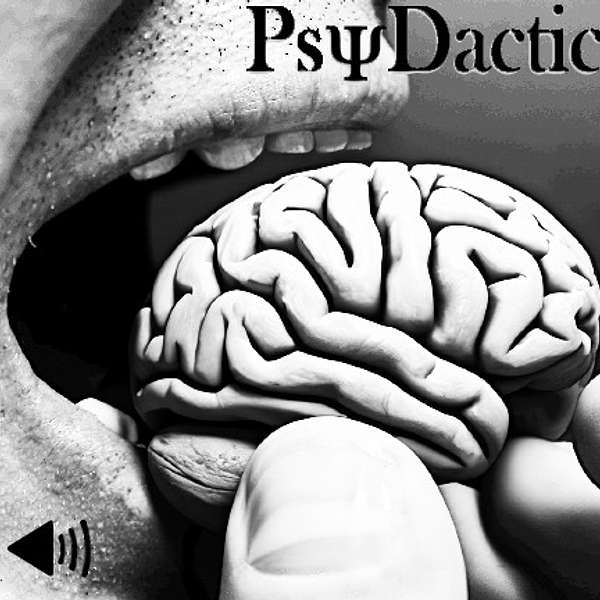
PsyDactic
A resource for psychiatrists and other medical or behavioral health professionals interested in exploring the neuroscientific basis of psychiatric disorders, psychopharmacology, neuromodulation, and other psychiatric interventions, as well as discussions of pseudoscience, Bayesian reasoning, ethics, the history of psychiatry, and human psychology in general.
This podcast is not medical advice. It strives to be science communication. Dr. O'Leary is a skeptical thinker who often questions what we think we know. He hopes to open more conversations about what we don't know we don't know.
Find transcripts with show-notes and references on each episodes dedicated page at psydactic.buzzsprout.com.
You can leave feedback at https://www.psydactic.com.
The visual companions, when available, can be found at https://youtube.com/@PsyDactic.
PsyDactic
In a Word - Agonist
--In today's episode, Dr. O'Leary explores agonists, inverse agonists, partial agonists, and antagonists. These terms describe how molecules bind to receptors and either increase, decrease, or prevent changes in receptor signaling. Agonists increase receptor activity, with full agonists like dopamine and serotonin raising activity to its maximum. Partial agonists can increase activity in the absence of full agonists but decrease it in their presence. Inverse agonists reduce the baseline activity of receptors. Antagonists block receptor activity without changing the baseline rate. We also discussed the complex interactions between these molecules and how their effects can vary depending on the presence of other molecules and the specific receptors involved.
Below are a couple of helpful references:
https://pmc.ncbi.nlm.nih.gov/articles/PMC2804881/
https://link.springer.com/article/10.2165/00023210-199605050-00007
Please leave feedback at https://www.psydactic.com or send any comments to feedback@psydactic.com.
References and readings (when available) are posted at the end of each episode transcript, located at psydactic.buzzsprout.com. All opinions expressed in this podcast are exclusively those of the person speaking and should not be confused with the opinions of anyone else. We reserve the right to be wrong. Nothing in this podcast should be treated as individual medical advice.
Below is a summary of the content in this this episode:
In a Word - Agonist
The current episode is about agonists, inverse agonists, partial agonists, and antagonists.
To understand this topic, we must first discuss how cells receive signals. G-protein coupled receptors send signals that activate or shut down various metabolic pathways and may result in DNA transcription. Tyrosine kinases are enzyme complexes that, when activated, add a phosphate group to a protein that either activates or de-activates it, which results in other changes in cell function. Ion channels are fast-acting and will either result in depolarization or hyperpolarization of a neuron, causing a neuron to fire or reducing its chance of firing. It is important to note that whether molecules are changing the activity of ion channels, G-protein coupled receptors, or kinases, the downstream effect of this may actually be to affect the constituent activity of another receptor, enzyme or ion channel.
Now, let’s discuss agonists, inverse agonists, partial agonists, and antagonists. All of these bind to either a signaling complex or an ion channel and can increase the activity of the signal or the ion flow, decrease the activity of the signal or ion flow, prevent any changes in the activity of the signal or ion flow, or place a new floor and ceiling on the signal frequency or ion flow.
An agonist increases the activity of its receptor. Many signaling pathways have a baseline or constituent rate of activity, as is true for enzymatic activity or ion channels. Agonists increase this activity. Full agonists are molecules that increase the activity to whatever is its natural maximum. Full agonists in the body are things like dopamine, norepinephrine, serotonin, melatonin, and vasopressin. Artificial agonists that doctors may prescribe include dopamine agonists pramipexole and ropinerol or serotonin agonists such as the triptans like sumatriptan, which are agonists at 5HT1b and 1d receptors.
A partial agonist increases the activity of a receptor or the ion channel or kinase in the absence of a full agonist, but it also decreases the activity of these in the presence of a full agonist or increases the constituent activity of a receptor even in the presence of an antagonist. Generally, full agonists are molecules produced by the body, such as dopamine, norepinephrine, or serotonin, but they might also be molecules that we have introduced. The same is true for an antagonist. Hypothetically, the effects of full dopamine agonists such as pramipexole or ropinerol (which mimic dopamine in the brain) will be somewhat reduced in the presence of a partial agonist, but not completely blocked. Risperidone is a D2 antagonist that decreases dopamine signaling in the tuberoinfundibular pathway, which can cause prolactinemia, breast swelling, milk production, and sexual dysfunction. Adding the partial agonist aripiprazole at low doses can increase the baseline dopamine signaling and mitigate the effects of risperidone. Examples of partial agonists are aripiprazole, brexpiprazole, and cariprazine, which are strong partial agonists at D2 and 5HT1A. Clozapine is a strong partial agonist at M1 and a weak partial agonist at 5HT1A. LSD binds 5HT1A as a full agonist and the 5-HT2A receptor as a strong partial agonist, among other receptors in the brain. Its action at 5HT2A is thought to contribute to its tendency to produce intense hallucinations and strange perceptual experiences.
An inverse agonist can only work on molecular complexes that have a baseline level of constituent activity. Instead of merely blocking a change in the activity, it produces less of or the opposite direction of effect. If a G-protein coupled receptor is normally signaling at a baseline rate, an inverse agonist would stabilize it at a lower rate or shut it off entirely. Hypothetically, an inverse agonist could reduce baseline flow through an ion channel or even reverse it. Normal flow through a transporter could be reversed; for example, instead of pumping serotonin into a cell, the serotonin transporter could start pumping it out of the cell. Inverse agonists are uncommon in clinical practice, or at least, uncommonly identified. Carvedilol, for example, which is a beta-blocker, not only prevents increased activity at beta-adrenergic receptors but also reduces their baseline activity, acting as a weak inverse agonist. Clozapine is a 5HT2A inverse agonist with high binding, and this is thought to be one of its main mechanisms for reducing psychotic symptoms. Remember that LSD, which causes psychosis, is a strong partial agonist at 5HT2s.
An antagonist is a molecule that binds to a receptor or ligand and prevents other things from binding to it. It does not change the firing rate of the receptor at baseline, but it prevents other molecules, such as full agonists, partial agonists, and inverse agonists from having an effect. Antagonists prevent signaling from being increased above or decreased below whatever is the baseline constituent rate of activity of the receptor.
Podcasts we love
Check out these other fine podcasts recommended by us, not an algorithm.

Mindhunting: Journeys in Forensic Psychiatry
Dr Michael Schirripa
Brain Science with Ginger Campbell, MD: Neuroscience for Everyone
Ginger Campbell, MD
